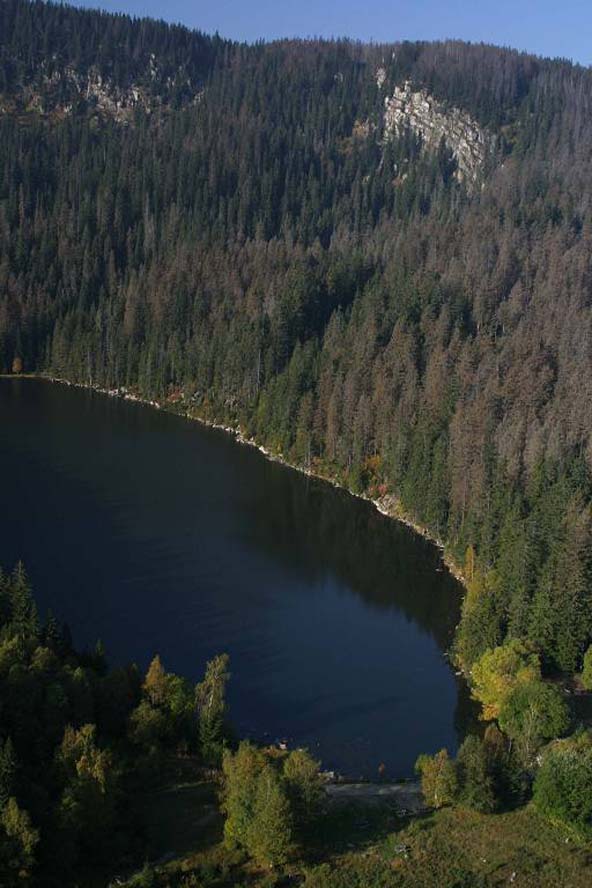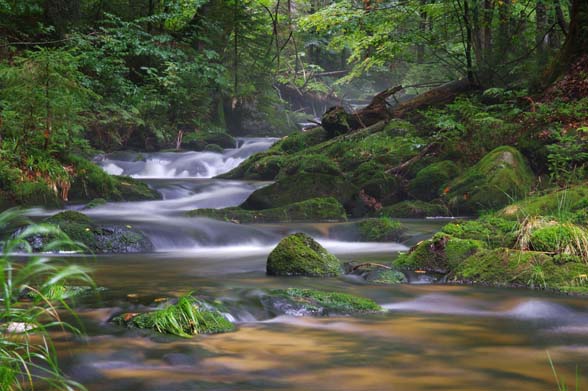Water

Lakes
The Bohemian Forest is among the most acidified lake districts in the world. Deposition of sulphur and nitrogen compounds in the area rapidly increased between 1950 and 1980, and reached a maximum in mid the 1980s. Owing to long-term occasional hydrobiological research and palaeolimnological studies, we are able to document the significant changes in the lake water chemistry and biodiversity (in particular the conspicuous reduction in crustacean and/or insect species in some lakes, as well as the extinction of fish). During the 1990s, acidic deposition decreased substantially, and its current levels are comparable to the early 20th century for SO42– and NH4+, and to the mid-1960s for NO3- . The decline in acidic deposition has resulted in a partial recovery of the Bohemian Forest lakes, as well as in an improvement of the Norway spruce physiology in their catchments.
Therefore, the Bohemian Forest lakes represent monitoring site with long history of monitoring (historical available data since 1871) and regular monitoring (biota and chemistry since 1984) provide a valuable background for long-term ecological research of the catchment–lake ecosystems that currently focuses on (i) chemical and biological recovery of the lakes, (ii) acidification effects on in-lake nutrient cycling, (iii) climatic effects on water chemistry, and (iv) catchment processes, including soil biogeochemistry and acidification impacts on vegetation (mountain spruce forests).
Monitoring project design
Location: Eight small glacial lakes are situated on forested slopes of the central summit of the Bohemian Forest . Two of the lakes, the most acidified Čertovo Lake (CT) and the mesotrophic (phosphorus rich) Plešné Lake (PL), have been selected for detail mass-budget studies since 1998. Map
Methodology: Projects cover an integrated catchment–lake approach, especially in the CT and PL catchments, and long-term limnological research of all eight lakes to study key processes and responses of different systems to the decreasing atmospheric pollution and the increasing air temperature. Besides regular monitoring of atmospheric deposition, water chemistry of the lakes and their tributaries, ongoing chemical and biological recovery of both aquatic and forest ecosystems from acid stress, including soil chemistry, microbial activity, vegetation, and forest disturbances in the lake catchments are studied.
Main outputs: The Bohemian Forest was the first lake district exhibiting a consistent decrease in NO3– concentrations. The decline in concentration of strong acid anions was compensated for by a decrease in concentrations of Al, protons (H+), and base cations (KOPÁČEK et al. 2002). The trend in lake water recovery from acidification continues until the present, even though at smaller rates than during the 1990s (MAJER et al. 2003). The forest dieback due to bark beetle infestation delayed (and even temporally reversed) recovery of water chemistry in some lakes (OULEHLE et al. 2013, VRBA et al. 2014).
The Bohemian Forest lakes offer a unique opportunity to assess recovery in different groups of planktonic (phytoplankton, ciliates, rotifers, and crustaceans) and littoral (Ephemeroptera, Plecoptera, Trichoptera, Heteroptera: Nepomorpha, and quillworts) organisms and to analyse both environmental and the biological constraints of biological recovery. Multivariate analyses revealed that the Al concentrations dominated in structuring the assemblages of phytoplankton, rotifers, and Nepomorpha and also affected crustaceans through the seston C:P ratio. Both direct (toxicity) and indirect (P availability) effects of Al control biological recovery in the Bohemian Forest lakes (VRBA et al. 2006, 2015). The actual Al concentrations influence both primary and secondary producers in particular lakes, and apparently control timing of biological recovery by forming the bottleneck that lags the recovery of some lakes.
STREAMS
The Bohemian Forest region belongs to an upper part of the Black and North Sea drainage basins, drainage divide of which follows mainly the border between the Czech Republic and Bavaria. The Šumava and Bavarian Forest stream networks differ each other due to different topography and land cover of these regions. Bavarian stream network drains various forest habitats and is characterized by very steep slope and numerous low-order streams. In contrast, Czech stream network (mainly its upper part) includes low-slope streams on large high-montane plateau, which drain large area of mires and meadows. Many streams are, therefore, naturally humic and acidic.
Streams and their floodplains host unique and diverse montane aquatic and terrestrial communities. However, anthropogenic activities affected some aquatic ecosystems in the Bohemian Forest. In the past two centuries, many streams were channelised and a system of artificial channels was constructed for the purpose of timber floating. Extensive channelization of small streams and construction of drainages for the agriculture and forestry led to disturbance of original water level dynamic in many wetlands in the area. The air-borne acidification that peaked in the 1970s and 1980s seriously affected the upper part of the steam network and their communities. Fortunately, in the past decade, a biological recovery (see lakes) [LINK to Lakes] could be documented. At present, natural disturbances by bark beetle infestation of forests and human-induced climate changes are expected to influence aquatic ecosystems.

Monitoring project design
Due to the different stream network character and also research priorities at both sides of the Bohemian Forest, the monitoring will focus on the biodiversity of montane streams across structural and elevational gradients at Bavarian side, whereas at Czech side, it will focus on stream restoration. Steep-slope stream network at Bavaria enables monitoring of aquatic insects inhabiting different levels of elevation. With this approach, not only biodiversity, but also upstream shifts induced by global warming can be detected. Furthermore, the influence of the surrounding forest structure naturally changed by bark beetle infestation can be studied. At Czech side, several streams were restored creating new meandering channels in their original bed sediments. Re-colonisation by aquatic invertebrates and dynamical development of both stream channels and their communities are investigated.
Monitoring of streams in the Bavarian Forest NP (starting in 2016)
Location: Seven streams spatially covering the Bavarian Forest National Park (in total 48 plots) Map
Methodology: Study sites (20-50m long sections) are located in 100m of elevation steps starting at the highest accessable stream point. Forest structure is documented using aerial photographs. Temperature is permanently monitored using data loggers. Aquatic communities are recorded using Multi-Habitat-Sampling method, i.e. taking 20 samples in respect to proportions of available substrate habitates.
Main outputs:
The planned monitoring should provide a broad overview of aquatic biodiversity and recovery after acidification. Another main focus is to document upstream shifts of aquatic organisms due to climate change. Moreover, this approach enables to detect influences by natural disturbances such as bark beetle infestation and thus will contribute to our understanding of ecological processes.
Monitoring of denaturalized streams in the Šumava NP (since 2014)
Location: Three restored streams, Žlebský potok and Jedlový potok (tributaries of Teplá Vltava stream near Dobrá) and Hučina stream (a tributary of Studená Vltava stream) Map
Methodology: Three mesohabitats (riffle, pool and flow) are studied at three stream sections differing in the channel restoration. Samples of macroinvertebrates and water, together with measuring of environmental variables, are taken four times a year. Long-term monitoring of the restored streams are expected.
Main outputs: The project will provide detailed data on the temporal succession of aquatic habitats and benthic invertebrates in the restored streams. The main outputs will include the assessment of the expected development of benthic communities towards more stable and diverse ones. The results will be also applicable for evaluating the success of ecological restoration implemented by the Šumava NP. If the restoration of these habitats is successful, then the restoration histories can provide valuable background information for restoration of other sites in similar conditions.
References: Lakes and streams

